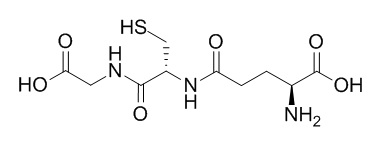Glutathione
Glutathione plays important roles in antioxidant defense, nutrient metabolism, and regulation of cellular events (including gene expression, DNA and protein synthesis, cell proliferation and apoptosis, signal transduction, cytokine production and immune response, and protein glutathionylation); glutathione deficiency contributes to oxidative stress, which plays a key role in aging and the pathogenesis of many diseases (including kwashiorkor, seizure, Alzheimer's disease, Parkinson's disease, liver disease, cystic fibrosis, sickle cell anemia, HIV, AIDS, cancer, heart attack, stroke, and diabetes).
Inquire / Order:
manager@chemfaces.com
Technical Inquiries:
service@chemfaces.com
Tel:
+86-27-84237783
Fax:
+86-27-84254680
Address:
1 Building, No. 83, CheCheng Rd., Wuhan Economic and Technological Development Zone, Wuhan, Hubei 430056, PRC
Providing storage is as stated on the product vial and the vial is kept tightly sealed, the product can be stored for up to
24 months(2-8C).
Wherever possible, you should prepare and use solutions on the same day. However, if you need to make up stock solutions in advance, we recommend that you store the solution as aliquots in tightly sealed vials at -20C. Generally, these will be useable for up to two weeks. Before use, and prior to opening the vial we recommend that you allow your product to equilibrate to room temperature for at least 1 hour.
Need more advice on solubility, usage and handling? Please email to: service@chemfaces.com
The packaging of the product may have turned upside down during transportation, resulting in the natural compounds adhering to the neck or cap of the vial. take the vial out of its packaging and gently shake to let the compounds fall to the bottom of the vial. for liquid products, centrifuge at 200-500 RPM to gather the liquid at the bottom of the vial. try to avoid loss or contamination during handling.
Phytomedicine.2024, 125:155350.
Biomol Ther (Seoul).2024, 32(2):214-223.
Environ Toxicol.2022, 37(3):514-526.
Food Chemistry: X.2022, 2022.100270
Industrial Crops and Products2024, 219:119123
Anticancer Res.2024, 44(3):1033-1044.
Bioorg Chem.2024, 152:107720.
Mie University2019, 10076.
Nutrients.2019, 12(1):E40
J Agric Food Chem.2017, 65(13):2670-2676
Related and Featured Products
J Nutr. 2004 Mar;134(3):489-92.
Glutathione metabolism and its implications for health[Pubmed:
14988435]
Glutathione (gamma-glutamyl-cysteinyl-glycine; GSH) is the most abundant low-molecular-weight thiol, and GSH/Glutathione disulfide is the major redox couple in animal cells. The synthesis of GSH from glutamate, cysteine, and glycine is catalyzed sequentially by two cytosolic enzymes, gamma-glutamylcysteine synthetase and GSH synthetase.
METHODS AND RESULTS:
Compelling evidence shows that GSH synthesis is regulated primarily by gamma-glutamylcysteine synthetase activity, cysteine availability, and GSH feedback inhibition. Animal and human studies demonstrate that adequate protein nutrition is crucial for the maintenance of GSH homeostasis. In addition, enteral or parenteral cystine, methionine, N-acetyl-cysteine, and L-2-oxothiazolidine-4-carboxylate are effective precursors of cysteine for tissue GSH synthesis. Glutathione plays important roles in antioxidant defense, nutrient metabolism, and regulation of cellular events (including gene expression, DNA and protein synthesis, cell proliferation and apoptosis, signal transduction, cytokine production and immune response, and protein glutathionylation). Glutathione deficiency contributes to oxidative stress, which plays a key role in aging and the pathogenesis of many diseases (including kwashiorkor, seizure, Alzheimer's disease, Parkinson's disease, liver disease, cystic fibrosis, sickle cell anemia, HIV, AIDS, cancer, heart attack, stroke, and diabetes).
CONCLUSIONS:
New knowledge of the nutritional regulation of GSH metabolism is critical for the development of effective strategies to improve health and to treat these diseases.
Food Chemistry,2000,68(4):475-80.
Automated HPLC analysis of glutathione and thiol-containing compounds in grape juice and wine using pre-column derivatization with fluorescence detection.[Reference:
WebLink]
METHODS AND RESULTS:
An easy and sensitive method for the analysis of Glutathione (GSH) and other thiol-containing compounds in grape juice and wine has been developed and optimized. Following a pre-column derivatization of thiols with o-phthalaldehyde (OPA) and 2 aminoethanol, isoindole derivatives are separated on reversed-phase HPLC column and quantified by a fluorescence detector. The minimum detection limits for thiols are: GSH, 3.3 nmol/l (1 g/l); cysteine, 22 mol/l (2.7 mg/L); methanethiol, 0.27 mol/l (12.8 g/l); ethanethiol, 0.65 mol/l (11 g/l). The method yields linear responses up to 40 and 21 mg/l for GSH and cysteine, respectively. GSH levels in two varietal grape juices during fermentation varied from 0 (starting juice) to 2.1 mg/l (wine) in Sauvignon blanc, while the GSH in a Palomino sample with 1.28 mg/l in the juice increased to 5.1 mg/l in the wine.
CONCLUSIONS:
This automated pre-column derivatization of thiols followed by an automatic injection procedure is sensitive, reproducible and rapid, with a run time of 35 min.



